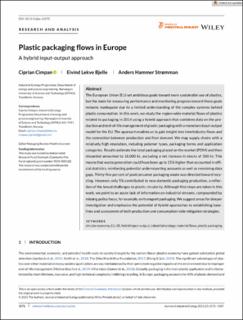| dc.contributor.author | Cimpan, Ciprian | |
| dc.contributor.author | Bjelle, Eivind Lekve | |
| dc.contributor.author | Strømman, Anders Hammer | |
| dc.date.accessioned | 2022-03-04T10:27:40Z | |
| dc.date.available | 2022-03-04T10:27:40Z | |
| dc.date.created | 2021-11-08T16:32:28Z | |
| dc.date.issued | 2021 | |
| dc.identifier.citation | Journal of Industrial Ecology. 2021, 25 (6), 1572-1587. | en_US |
| dc.identifier.issn | 1088-1980 | |
| dc.identifier.uri | https://hdl.handle.net/11250/2983084 | |
| dc.description.abstract | The European Union (EU) set ambitious goals toward more sustainable use of plastics, but the basis for measuring performance and monitoring progress toward these goals remains inadequate due to a limited understanding of the complex systems behind plastic consumption. In this work, we study the region-wide material flows of plastics related to packaging in 2014 using a hybrid approach that combines data on the production and end-of-life management of plastic packaging with a monetary input-output model for the EU. The approach enables us to gain insight into interindustry flows and the connection between production and final demand. We map supply chains with a relatively high resolution, including polymer types, packaging forms and application categories. Results estimate the total packaging placed on the market (POM) and then discarded amounted to 18,000 kt., excluding a net increase in stocks of 500 kt. This means that waste generation could have been up to 15% higher than accounted in official statistics, reinforcing potential underreporting accounts as well as remaining data gaps. Thirty-five percent of postconsumer packaging waste was directed toward recycling. However, only 5% contributed to new domestic packaging production, a reflection of the broad challenges to plastic circularity. Although first steps are taken in this work, we point to an acute lack of information on industrial streams, compounded by missing policy focus, for example, on transport packaging. We suggest areas for deeper investigation and emphasize the potential of hybrid approaches to establishing baselines and assessment of both production and consumption-side mitigation strategies. | en_US |
| dc.language.iso | eng | en_US |
| dc.publisher | Wiley | en_US |
| dc.relation.uri | https://onlinelibrary.wiley.com/doi/full/10.1111/jiec.13175 | |
| dc.rights | Navngivelse 4.0 Internasjonal | * |
| dc.rights.uri | http://creativecommons.org/licenses/by/4.0/deed.no | * |
| dc.title | Plastic packaging flows in Europe: A hybrid input-output approach | en_US |
| dc.type | Peer reviewed | en_US |
| dc.type | Journal article | en_US |
| dc.description.version | publishedVersion | en_US |
| dc.source.pagenumber | 1572-1587 | en_US |
| dc.source.volume | 25 | en_US |
| dc.source.journal | Journal of Industrial Ecology | en_US |
| dc.source.issue | 6 | en_US |
| dc.identifier.doi | 10.1111/jiec.13175 | |
| dc.identifier.cristin | 1952467 | |
| cristin.ispublished | true | |
| cristin.fulltext | original | |
| cristin.qualitycode | 2 | |

